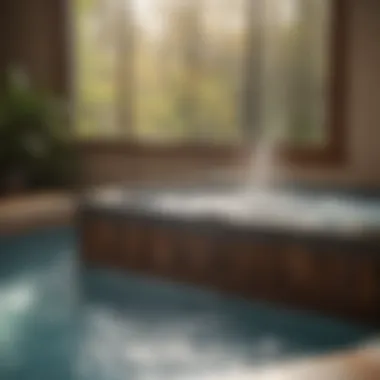The Benefits of Hot Tubs for Luxurious Relaxation


Intro
In recent years, the hot tub has emerged as an essential element for relaxation and leisure in many homes. This phenomenon transcends mere luxury, intertwining with health benefits and emotional well-being. Understanding the many ways in which hot tubs serve our lives can guide homeowners and design enthusiasts in making informed decisions.
Hot tubs offer a unique blend of therapeutic relaxation. They can relieve stress, alleviate muscle aches, and even improve sleep quality. Furthermore, integrating a hot tub into the home environment introduces an aesthetic dimension, turning an ordinary bathing experience into a lavish ritual. Exploring various design inspirations and product recommendations can enhance this experience, making it truly exceptional.
Unlocking the potential of hot tubs involves more than just selecting a model. It requires thoughtfulness toward the broader context: the space, the accessodes, and overall ambiance. This article endeavors to provide insights into creating a serene oasis in the home, enriching everyday life through strategic installation and design choices.
Foreword to Hot Tubs
The introduction of hot tubs serves as a foundational segment in understanding the broad implications of this luxurious bathing practice. Hot tubs have transcended their basic function over the years, evolving into symbols of relaxation and wellness. Their importance is underscored by the amalgamation of health benefits, aesthetic enhancements, and social bonding they provide. A thoughtfully integrated hot tub can transform a mundane space into a serene retreat.
Definition and Functionality
Hot tubs are large containers filled with heated water, designed for soaking, relaxation, and often therapeutic purposes. Their operation typically involves a heating system, water jets for massage, and filtration for cleanliness. Users can enjoy a soothing environment that promotes relaxation and reduces physical tension. The design of a hot tub varies from simple inflatable models to elaborate therapeutic units resembling small swimming pools. Each type serves various needs, making hot tubs highly versatile.
Historical Context
The roots of hot tub bathing can be traced back to ancient civilizations, where communal bathing was a key part of social culture. The Romans, for example, had extensive bath complexes that integrated heated baths for relaxation and social interaction. Over time, the Japanese introduced the onsen, or hot spring bath, emphasizing the connection between nature and relaxation.
In modern times, the introduction of personal and portable hot tubs in the late 20th century made this form of luxury accessible to many households. The shift from public bathing facilities to private sanctuaries in homes marks a significant change in bath culture. This evolution reflects changes in lifestyle, where personal well-being and home relaxation spaces gained prominence.
"The integration of hot tubs into our bathing routines today represents not just a luxury, but a commitment to health and well-being in our personal space."
Understanding the definition and historical context of hot tubs enriches the conversation on their utility and benefits, setting the stage for deeper exploration into health advantages and installation considerations.
Health Benefits of Hot Tub Baths
The integration of hot tubs into bathing routines presents an array of health benefits that merit consideration. Both physical and mental enhancements can significantly improve overall well-being. The hot tub experience serves not only as a source of relaxation but also as a tool for therapeutic relief. Understanding these advantages can help homeowners appreciate their potential beyond mere luxury.
Muscle Relaxation and Pain Relief
One of the most celebrated benefits of hot tubs is their ability to promote muscle relaxation and alleviate pain. Immersion in warm water increases blood flow, which helps decrease muscle tension. The heat works on the body similarly to heat therapy, easing stiff muscles and joint pain. For individuals suffering from conditions like arthritis or fibromyalgia, regular hot tub usage can be a crucial component of pain management.
Additionally, the buoyancy provided by the water reduces pressure on the body’s joints. This makes stretching and movements easier, enhancing flexibility. In complex muscle groups, hot tub therapy supports recovery after intense workouts, reducing soreness and speeding up healing.
"Hydrotherapy offers a gentle yet effective approach to managing pain, proving beneficial for many conditions that impact daily life."
Mental Wellness and Stress Reduction
The positive influence of hot tubs on mental well-being cannot be overstated. The calming effect of water immersion promotes a state of relaxation that is beneficial for mental health. Stress levels can drop significantly in a hot tub, a factor that is vital considering modern life often brings various pressures.
When in a hot tub, the body releases endorphins, which are known as the happiness hormones. This process can lead to improved mood and reduced symptoms of anxiety or depression. The quiet environment that a hot tub often provides allows for contemplation or socialization, both of which further contribute to stress relief.
Relaxation Techniques While Bathing
- Practice deep breathing exercises.
- Listen to soothing music or nature sounds.
- Use aromatherapy oils for a calming effect.
Improved Sleep Quality
Another significant advantage of regular hot tub baths is the positive impact on sleep quality. Bathing in heated water raises body temperature, which can subsequently drop upon exiting the tub. This decrease in temperature signals to the body that it is time to rest, facilitating the transition into deeper sleep.


Research suggests that consistent hot tub usage can assist in overcoming mild insomnia. The tranquil atmosphere created during hot tub use further enhances the relaxation process, making it easier to fall asleep and stay asleep.
Types of Hot Tubs
Understanding the various types of hot tubs is crucial for homeowners seeking to enhance their bathing experience. Each type comes with unique benefits, features, and considerations suitable for different needs and preferences. This exploration will help readers make informed decisions, based on their lifestyle, budget, and planned use.
Inflatable Hot Tubs
Inflatable hot tubs represent a popular entry point for many individuals who desire the luxury of a hot tub without the commitment and expense of traditional models. Their portable nature allows for easy setup and storage. Inflatable hot tubs can typically accommodate several people, making them great for social gatherings.
Benefits:
- Cost-effective: Generally more affordable than fixed models.
- Easy installation: No professional help needed.
- Mobility: Can be moved or stored away based on the season.
It is essential to consider the durability of these hot tubs. While they are made from robust materials, they may not last as long as hard-walled options. Users should also be cautious regarding the setup surface to avoid punctures.
Wood-Fired Hot Tubs
Wood-fired hot tubs offer a unique experience that differentiates them from standard models. They rely on direct fire to heat the water, providing a rustic ambiance that appeals to many outdoor enthusiasts. The interaction with nature, along with the warmth of the wood, creates a soothing experience.
Considerations:
- Sustainability: Options to use eco-friendly wood.
- Aesthetic Appeal: Natural wood blends well with outdoor settings.
- Maintenance: Regular cleaning of the firebox and ensuring proper wood management is essential.
Users looking for an off-grid experience often favor this type. However, they require more effort in terms of heating and maintenance compared to electric hot tubs.
Jacuzzi and Spa Hot Tubs
The epitome of luxury, Jacuzzi and spa hot tubs, are designed for those who want a more permanent and lavish addition to their home. They often come equipped with advanced features such as jets, lights, and temperature controls.
Advantages:
- Therapeutic Benefits: Many models focus on hydrotherapy with adjustable jets.
- Customization: Options to choose size, features, and layout based on personal preferences.
- Longevity: Built to last, providing a good return on investment over time.
When considering a Jacuzzi or spa hot tub, potential buyers should evaluate their space, budget, and the potential for regular use. They might be subjected to stricter permits and installation guidelines, making prior research vital.
"Choosing the right type of hot tub is not just about luxury; it also connects with lifestyle needs and environmental considerations."
Selecting the appropriate hot tub is a significant decision that can influence the overall enjoyment and benefits derived from this relaxing retreat. Whether for personal use or hosting guests, knowing different types helps in making the right choice.
Hot Tub Installation Considerations
The installation of hot tubs is a pivotal aspect of enhancing their benefits. Understanding how to properly integrate a hot tub into a home can significantly impact user experience. This section addresses several important factors to consider when installing a hot tub. These include choosing the right location, adhering to electrical and plumbing requirements, and understanding permitting and regulations. Such considerations ensure that the hot tub not only serves its luxurious purpose but also aligns with practical aspects of safety and maintenance.
Choosing the Right Location
Outdoor vs Indoor Options
Selecting between outdoor and indoor hot tub installation holds substantial importance. Each choice carries its own characteristics and potential impact on user enjoyment.
- Outdoor Hot Tubs: These options often enhance the overall bathing experience through natural surroundings. Imagine bathing under the stars or enjoying a sunny afternoon. The accessibility to nature can elevate relaxation and allows for social gatherings around the tub.
- Indoor Hot Tubs: On the other hand, indoor installations provide privacy and year-round use without being affected by weather conditions. Additionally, they can be an integral part of an indoor wellness retreat, allowing for a distinct personal area within one’s home.


When considering these options, think about which environment aligns with your lifestyle and personal preferences. Each choice has its unique advantages, which can lead one to prioritize ambiance over privacy or vice versa.
Proximity to Utilities
Evaluating the proximity to utilities is critical in the installation process. Hot tubs require access to electrical power and water supply, and this proximity can dictate installation complexity.
- Electrical Access: Hot tubs often need a dedicated electrical source, which may involve extensive work if the nearest outlet is insufficient. Such considerations can incur higher costs depending on the distance.
- Water Supply: Similarly, being near water sources makes filling and maintaining the hot tub much easier. It is essential to consider any potential modifications required for plumbing if the location is far from existing connections.
Electrical and Plumbing Requirements
Understanding electrical and plumbing criteria is essential for hot tub installation. Improper connections can lead to dangers or inefficient performance. Ensuring that all electrical work is performed by a qualified electrician adds safety and reliability. Additionally, plumbing must be meticulously connected to avoid leaks and ensure proper drainage. This attention to detail prevents costly repairs later.
Permitting and Regulations
Acquiring necessary permits and adhering to local regulations cannot be overlooked. Many regions require permits for hot tub installations. These regulations ensure safety standards are met and that installations do not violate local codes. Failure to comply may result in fines or forced removal. Therefore, consulting with local authorities before installation can save considerable hassle in the future.
In summary, careful consideration of location, utility access, electrical and plumbing requirements, along with essential permits contributes to a successful hot tub installation. Such planning lays the groundwork for enjoying hot tubs as a source of relaxation and health benefits.
Designing with Hot Tubs
Incorporating hot tubs into a home environment requires thoughtful design choices. This section explores how design influences the functionality and aesthetic value of hot tubs. When planned well, hot tubs can seamlessly blend into their surroundings, enhancing both relaxation and enjoyment.
Incorporating Hot Tubs into Outdoor Spaces
Landscaping and Ambiance
Creating an inviting outdoor space around a hot tub involves strategic landscaping and lighting. The layout of plants, pathways, and seating can establish a relaxing oasis. Key characteristics of effective landscaping include selecting plants that complement the style of the hot tub and choosing soothing color palettes. This choice contributes to a tranquil environment that supports relaxation.
A unique feature of landscaping revolves around the use of natural elements such as stones or water features. These can provide a calming influence and enhance the visual appeal of the hot tub area. However, careful planning is crucial, as excessive clutter or inappropriate plant types can detract from the ambiance, making the space feel overwhelming.
Privacy Considerations
Privacy is an essential aspect when designing spaces that include hot tubs. Effective strategies for privacy inclusion may involve designing natural barriers, like hedges or fences, to create secluded spaces that encourage relaxation. The key characteristic of private hot tub areas is the ability to provide a personal retreat away from daily life. This helps enhance the experience of bathing significantly.
A unique element in this context is using trellis structures or pergolas, which not only offer privacy but also can be adorned with climbing plants. However, it is necessary to consider the potential downsides, such as maintenance of plants and structures, which can be time-consuming.
Styles and Aesthetics for Indoor Use
When integrating hot tubs into interior spaces, style is a key focus. Options range from modern minimalist designs to more traditional styles. Factors like material choice, color schemes, and the overall design theme of the home influence the aesthetics of the hot tub area.
Practical considerations for indoor installations should include adequate ventilation and moisture control to prevent water damage. Selecting the right finish on hot tubs can vastly influence the interior's mood and functionality. Understanding these elements will ensure the incorporation of hot tubs not only enhances comfort but also serves as a stylish focal point in the home.
Maintenance of Hot Tubs
Maintaining a hot tub is crucial for ensuring its longevity and optimal performance. Regular care not only prolongs the life of the hot tub but also enhances the overall bathing experience. Addressing both cleaning and water quality management is essential. Each vital aspect contributes to hygiene, safety, and efficiency in your hydrotherapy sessions.
Regular Cleaning Practices
Regular cleaning helps prevent the build-up of dirt and other contaminants. It is recommended to establish a weekly and monthly cleaning routine. Consider these practices:
- Surface Cleaning: Wipe down the hot tub's surface with a soft cloth and gentle cleaner. Avoid harsh chemicals as they can damage the materials.
- Filter Cleaning: The filter should be cleaned every month. Rinse it with a hose to remove debris. Replace it as indicated in the manufacturer’s instructions.
- Drain and Refill: It’s advised to drain and refill the hot tub every three to four months, or sooner if the water appears dirty or cloudy.


Implementing these methods will improve the conditioning of the water and enhance the experience of relaxation in your hot tub.
Water Quality Management
Managing water quality is paramount for a safe and enjoyable bath. Proper water treatment not only keeps the hot tub inviting but also reduces health risks posed by bacteria and algae.
Testing Water Chemistry
Testing water chemistry is a key practice for hot tub safety. Regular checks allow you to monitor pH, alkalinity, and sanitizer levels. A balanced chemistry contributes to a more pleasant bathing experience.
- Key Characteristic: The immediate identification of imbalance in water prevents irritation to skin and eyes.
- Beneficial Choice: Regular testing is widely regarded as the first step to safeguarding water quality.
- Advantages: By maintaining the right levels, you secure a clean, safe environment that maximizes the benefits of hot tub use.
Using Chemicals Safely
Using chemicals safely is integral when managing hot tub water. Chemicals help maintain cleanliness, but they must be utilized with caution.
- Key Characteristic: Proper use ensures the effectiveness of sanitizers while minimizing harm.
- Beneficial Choice: Following guidelines for chemical use secures health and safety for all users.
- Advantages: Understanding how to store and apply chemicals mitigates risks associated with leaks and spills, promoting a safer bathing environment.
Cost Analysis of Hot Tub Ownership
Understanding the cost analysis of hot tub ownership is critical for anyone considering the incorporation of this luxury into their home. Given the substantial initial outlay and the ongoing expenses associated with hot tub maintenance, a thorough examination of costs can help potential buyers make informed decisions. This section unpacks various elements related to cost, with a focus on both initial purchase costs and long-term maintenance expenses.
Initial Purchase Costs
The initial purchase costs of a hot tub can vary widely, depending on several factors including size, type, and features. Typically, homeowners can expect to spend anywhere from $3,000 to over $15,000 for a new hot tub.
- Type of Hot Tub: Inflatable hot tubs generally are less expensive at around $300 to $1,500, making them a more budget-friendly option. Conversely, high-end options like Jacuzzi or spa hot tubs can significantly increase the initial investment.
- Features: Additional features such as 'smart' technology, lighting, and upgraded materials may also add to the cost. Consider if these features are essential or simply attractive add-ons.
- Installation: It's essential to factor in installation costs. Professional installation can add between $300 and $1,200 to the overall expenditure, depending on local labor rates and the complexity of the setup.
Before making a decision, it is wise to create a budget that accounts for all elements of hot tub acquisition. This ensures transparency in financial commitment and minimizes surprises.
Long-term Maintenance Expenses
Owning a hot tub extends beyond the initial purchase; ongoing maintenance expenses can accumulate over time. Expected long-term costs can include
- Chemicals: Maintaining proper water quality is essential. Chemical costs can range from $20 to $50 monthly for sanitizers, pH balancers, and other necessary treatments.
- Energy Costs: Depending on usage, electricity bills can see a noticeable increase, averaging around $30 to $50 per month. Insulation and energy-efficient settings can help mitigate these costs.
- Repairs and Replacement Parts: Regular wear and unexpected issues can lead to repair needs. Budgeting for potential repairs is critical, ranging from easy fixes like pump replacements to more significant structural repairs. It’s wise to set aside about $200 to $500 yearly for unforeseen repairs.
- Cover Replacement: A good-quality cover is essential for energy savings and reduces debris in your hot tub. Replacing covers can run between $200 and $600 every 5-7 years.
End and Summary of Key Takeaways
The utilization of hot tubs in bathing routines presents a variety of advantages that extend beyond mere relaxation. They serve as both a tool for physical solace and an enhancement of one's mental health. This article articulates several compelling reasons why incorporating a hot tub can be a transformative experience in one's home.
First, the health benefits are noteworthy. Regular use of hot tubs can relieve muscle tension and reduce chronic pain. The warmth from the water soothes sore muscles, allowing for relaxation that is difficult to achieve elsewhere. Mental wellness improves with each soak, contributing to reduced stress levels and better sleep. These benefits result from both physical factors, such as buoyancy and heat, and psychological elements, including personal time to unwind.
Moreover, installation considerations also play an important role. Understanding the proper location, electrical, and plumbing requirements ensures a safe and effective setup. Recognizing whether to choose outdoor or indoor options based on personal preference and space availability can streamline the process.
In terms of design, integrating hot tubs into home aesthetics creates a cohesive feel. Whether surrounded by landscaping or included in a more contemporary interior layout, hot tubs offer versatility. Not only do they provide relaxation, but they also elevate the visual appeal of living spaces.
Maintenance remains a crucial topic for hot tub owners. Regular cleaning and water quality checks are mandatory for enjoying these benefits long term. Understanding how to manage water chemistry safely keeps both the hot tub and users in top shape.
Finally, an analysis of costs encompasses both initial investment and long-term maintenance. This understanding can assist homeowners in making informed decisions, balancing luxury with affordability.
Key Takeaways: Incorporating hot tubs into daily routines enhances physical and mental health while requiring careful planning and maintenance.
Final Thoughts on Hot Tub Integration
Integrating a hot tub into a bathing routine offers more than momentary pleasure; it can result in sustained benefits. Not only do they provide immediate therapeutic advantages, but they also promote a lifestyle centered around relaxation and care. In considering hot tub ownership, one must reflect on personal needs, spaces, and budgets.
Ultimately, this investment reflects a commitment to wellness in both mind and body. Whether one seeks a retreat from daily stressors or a luxurious way to end a long day, a hot tub can fulfill these desires.
The key lies in embracing the lifestyle that comes with hot tub integration. Manage water quality, plan installations wisely, and encourage routines that prioritize relaxation. With thoughtful consideration, a hot tub becomes more than just a feature; it evolves into a sanctuary for rejuvenation.



